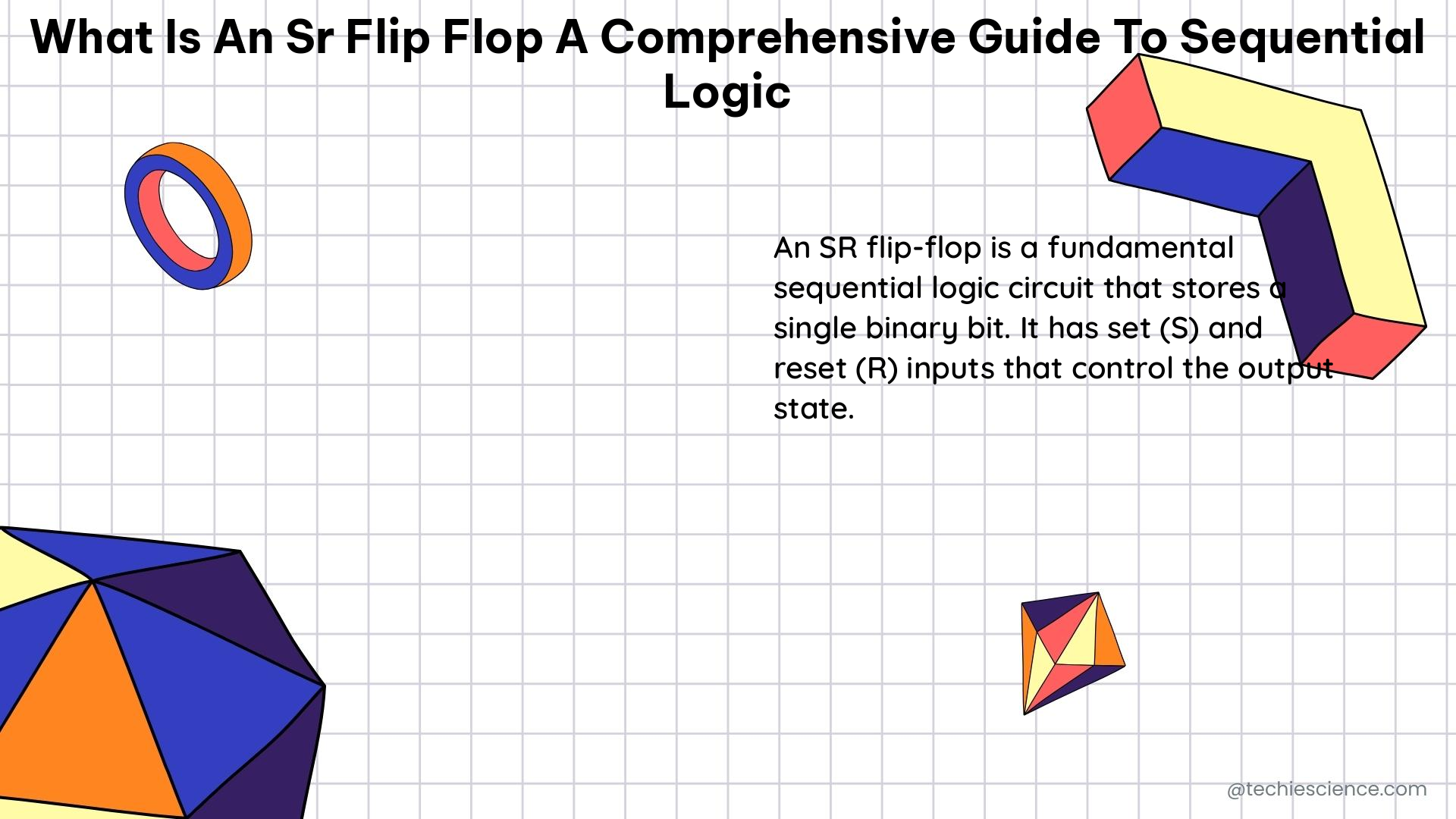An SR Flip-Flop (Set-Reset Flip-Flop) is a fundamental building block in sequential logic circuits, used for storing binary data. It is a bi-stable circuit with two stable states, where the output can be set to logic 1 by applying logic 0 to the S input and reset to logic 0 by applying logic 0 to the R input. The basic SR Flip-Flop circuit consists of two gates connected in a positive feedback loop, ensuring that the output remains stable in one of the two states.
Understanding the SR Flip-Flop
The SR Flip-Flop is a type of bistable multivibrator, which means it has two stable states and can be used to store one bit of information. The two stable states are represented by the output signals Q and Q’, where Q is the true output and Q’ is the complement of Q.
Truth Table and Characteristic Equation
The truth table for an SR Flip-Flop is as follows:
| S | R | Q | Q’ |
|---|---|---|---|
| 0 | 0 | Qprev | Q’prev |
| 0 | 1 | 0 | 1 |
| 1 | 0 | 1 | 0 |
| 1 | 1 | X | X |
where Qprev and Q’prev are the previous values of Q and Q’, respectively, and X indicates an undefined or forbidden state.
The characteristic equation for an SR Flip-Flop is given by:
Qnext = S + Q’prev
Q’next = R + Qprev
where Qnext and Q’next are the next values of Q and Q’, respectively.
Construction Methods
SR Flip-Flops can be constructed using either NOR gates or NAND gates. The main difference between the two is the logic level of the inputs:
- NOR Gate-based SR Flip-Flop: Works on active-high inputs, where logic 0 on the S input sets the output to 1, and logic 0 on the R input resets the output to 0.
- NAND Gate-based SR Flip-Flop: Works on active-low inputs, where logic 0 on the S input sets the output to 1, and logic 0 on the R input resets the output to 0.
The choice between NOR and NAND gate-based SR Flip-Flops depends on the specific requirements of the circuit and the overall logic design.
Applications of SR Flip-Flops

SR Flip-Flops have several applications in digital electronics and computer systems, including:
- Memory Storage: SR Flip-Flops serve as the basic building blocks for computer memories, where they are used to store individual bits of information.
- Sequential Logic Circuits: SR Flip-Flops are used as the fundamental elements in various sequential logic circuits, such as counters, shift registers, and state machines.
- Synchronization: SR Flip-Flops can be implemented in synchronous systems to synchronize the operation of different components, ensuring that data is transferred and processed correctly.
- Debouncing: SR Flip-Flops can be used to debounce mechanical switches, preventing multiple triggering events due to switch bouncing.
- Timing and Delay Circuits: SR Flip-Flops can be used to create timing and delay circuits, where the output state is determined by the timing of the input signals.
Limitations and Advancements
While SR Flip-Flops are simple and fundamental elements in sequential logic circuits, they have some limitations. One of the main limitations is the forbidden state, where both the S and R inputs are equal to logic 1. In this case, the output becomes indeterminate, which is not allowed in practical circuits.
To address this issue, more advanced flip-flop types have been developed, such as the JK Flip-Flop. The JK Flip-Flop has no forbidden input states and provides additional functionality, such as the ability to toggle the output state.
Despite these limitations, SR Flip-Flops remain an essential concept in digital electronics, serving as the basis for more complex sequential logic circuits. They are widely used in various applications, from computer memories to industrial control systems, and continue to play a crucial role in the design and implementation of digital systems.
Conclusion
In summary, the SR Flip-Flop is a fundamental element in sequential logic circuits, used for storing binary data. It has two stable states, and its output can be set or reset by applying appropriate logic levels to its inputs. The truth table, characteristic equation, and construction methods for SR Flip-Flops have been discussed, along with their applications and the differences between NOR and NAND gate-based implementations. While SR Flip-Flops have some limitations, they remain an essential concept in digital electronics, serving as the building blocks for more complex sequential logic circuits.
References
- Flip Flop Basics – Types, Truth Table, Circuit, and Applications. (2024-05-21). Retrieved from https://www.electronicsforu.com/technology-trends/learn-electronics/flip-flop-rs-jk-t-d
- SR Flip Flop. (2024-05-14). Retrieved from https://www.geeksforgeeks.org/sr-flip-flop/
- SR Flip-flops. (n.d.). Retrieved from https://learnabout-electronics.org/Digital/dig52.php

The lambdageeks.com Core SME Team is a group of experienced subject matter experts from diverse scientific and technical fields including Physics, Chemistry, Technology,Electronics & Electrical Engineering, Automotive, Mechanical Engineering. Our team collaborates to create high-quality, well-researched articles on a wide range of science and technology topics for the lambdageeks.com website.
All Our Senior SME are having more than 7 Years of experience in the respective fields . They are either Working Industry Professionals or assocaited With different Universities. Refer Our Authors Page to get to know About our Core SMEs.